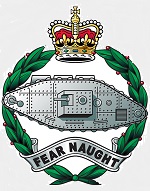AFV AFV019 British Matilda Mk. II Infantry Tank - "Griffin", Malta Tank Squadron, Royal Tank Regiment, Malta, 1942 (1:43 Scale)
"After [El] Alamein, we never had a defeat."
- British Prime Minister Winston Churchill
 The Infantry Tank Mark II, best known as the Matilda, was a British infantry tank of the Second World War.
The Infantry Tank Mark II, best known as the Matilda, was a British infantry tank of the Second World War.
The design began as the A12 specification in 1936, as a gun-armed counterpart to the first British infantry tank, the machine gun armed, two-man A11 Infantry Tank Mark I. The Mark I was also known as Matilda, and the larger A12 was initially known as the Matilda II or Matilda senior. The Mark I was abandoned in 1940, and from then on the A12 was almost always known simply as "the Matilda".
With its heavy armor, the Matilda II was an excellent infantry support tank but with somewhat limited speed and armament. It was the only British tank to serve from the start of the war to its end, although it is particularly associated with the North Africa Campaign. Only two were available for service by the outbreak of the World War II in 1939. It was replaced in front-line service by the lighter and less costly Infantry Tank Mk III Valentine beginning in late 1941.
The Matilda Senior weighed around 27 long tons (27 t; 30 short tons), more than twice as much as its predecessor, and was armed with an Ordnance QF 2-pounder (40 mm) tank gun in a three-man turret. The turret traversed by hydraulic motor or by hand through 360 degrees; the gun could be elevated through an arc from −15 to +20 degrees. One of the most serious weaknesses of the Matilda II was the lack of a high-explosive round for its main gun. A high-explosive shell was designed for the 2-pounder but was rarely issued, as the bursting charge was so small. The main weapon against un-armored targets was its machine gun.
The Matilda II had a conventional layout, with the driver's compartment located at the front of the tank's hull, the fighting compartment with the turret in the center and the engine and transmission housed in the rear. The driver's position was normally accessed by a single hatch in the roof of the hull, and protected by a rotating armored cover which could be held locked in either fully open or closed positions; emergency egress was made possible by a large escape hatch under the driver's seating position. The driver also had a direct vision viewing port with manually operated armored shield and a single Mk IV periscope to use when buttoned up.
Like many other British infantry tanks, it was heavily armored. The front glacis was up to 78 mm (3.1 in) thick; the nose plates top and bottom were thinner but angled. The sides of the hull were 65 to 70 millimetres (2.6 to 2.8 in) and the rear armor, protecting the engine to sides and rear, was 55 millimetres (2.2 in).
Pictured here is a 1:43 scale diecast replica of a British Matilda Mk.II infantry tank that was attached to the Malta Tank Squadron, Royal Tank Regiment then deployed to Malta during 1942.
Now in stock!
Dimensions:
Length: 5-1/2-inches
Width: 3-inches
Release Date: August 2022
Historical Account: "Malta Tanks" - The Malta Tanks was a unit designation for an independent Royal Tank Regiment (RTR) unit made of a mixture of British tank types deployed to Malta in World War II.
The first armored unit destined for Malta was organized in 1940. The unit was formed with a strength of 5 officers and 62 other ranks; and was attached to the 44th Battalion RTR prior to its embarkation for Malta; the unit was part of Malta Command.
On December 21st, 1942, A Squadron, 6 Royal Tank Regiment amalgamated with the Malta Tank Troop and is referred to was reported as "Malta Tanks" with effect from this date. The whole unit remained under Central Infantry Brigade for administration. Malta Tanks was commanded by Major S D G Longworth. X Squadron had set sail with 13 A13 Cruiser tanks but five were lost when the ship carrying them struck a mine and sank. Other tanks (Valentines) also arrived in 1942.
The unit never became larger than 19 vehicles and did not see action. It spent the war patrolling, boosting morale across central Malta and acting as tugs removing damaged aircraft from runways.


